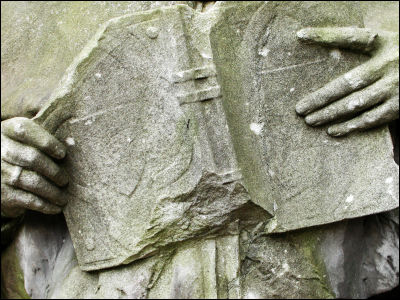本を美しく修復する方法、中世の場合

本が破れたり物が壊れたりした時に、破損部分を「傷」と考えて捨ててしまうこともありますが、クリエイティビティを炸裂させれば「傷」が「美しさ」に生まれ変わることがあります。作家のPaul Cooperさんが中世に行われていた本の修復方法についてTwitterに投稿しており、当時の世界を垣間見ることができます。
紙が主流になる前、本の素材として使われていたのは動物の皮でした。羊皮紙と呼ばれる素材は脱毛し、水にさらした皮を木枠に強く張ることで作られますが、剥皮または脱毛工程中に傷があると木枠に張る段階で穴が空いてしまいます。穴があいた羊皮紙でも本に使われたようで、作り手たちによってクリエイティブな修復が行われました。

羊皮紙は非常に高価だったので穴が空いていたり傷がついていたりしても捨てられることはなく、安価な本の製造に回たとのこと。以下のように事務的に修復されたものもあれば……
Parchment was too valuable to simply throw away, so the damaged pieces were used to create cheaper books.
— Paul Cooper (@PaulMMCooper) 2018年4月10日
People didn't seem to mind. Scribes simply wrote around the holes. But others took a more creative approach.
(Leiden, Universiteitsbibliotheek, BPL25, 9th century) pic.twitter.com/IyslLmLcpM
クリエイティビティを炸裂させたものも。紫とピンクの糸で穴が修復されています。文章を書く上で穴の空いた部分は避けられていて、文字を書く前に既に穴が空いていることがわかります。
A thread on the creative and beautiful ways that the artists of the past repaired the flaws in torn and damaged manuscripts. pic.twitter.com/81YSAhKGot
— Paul Cooper (@PaulMMCooper) 2018年4月10日
傷を利用して個性や美を生み出すという点は金継ぎと共通するところがあります。以下はヴァドステーナ修道院に収蔵された書物の1ページ。書物は14世紀に書かれたものです。糸の素材はシルクで、黒い部分は硫酸鉄とタンニンで染められていたため、もろくなっていたとのこと。
Some repairs were workmanlike and didn't draw attention to themselves. But others turned the flaws in the manuscripts into decorations in their own right.
— Paul Cooper (@PaulMMCooper) 2018年4月10日
This Swiss manuscript from the monastery of St. Gallen is one of the most beautiful examples.
(https://t.co/M87uuArZ1x) pic.twitter.com/OQUL9lEYT8
複数の色を用いて修復が行われている本もあります。
Even in situations where one colour might do, the embroiderers have chosen to add vivid colours, turning the book's flaws into a new part of its charm.
— Paul Cooper (@PaulMMCooper) 2018年4月10日
(https://t.co/QWoCozHQ3H) pic.twitter.com/1ihoyUndBT
ヤコブス・デ・ウォラギネによって編集された「レゲンダ・アウレア(黄金伝説)」のコピーの1ページ。鮮やかな修復は「チューリッヒの工芸にも似ている」と記されています。
Some parchments were damaged multiple times, and had to be repaired more than once on the same page, the scribe simply writing around the holes.
— Paul Cooper (@PaulMMCooper) 2018年4月10日
(Universitätsbibliothek, Ms. L 34 https://t.co/OAHoYQJQV0) pic.twitter.com/MBbb7p4LCi
スイスの図書館に収蔵されていた1冊には、上記とはまた異なった形の修復が施されています。
The use of poorer grades of parchment allowed texts to be made more cheaply, and thus reach a larger audience, meaning knowledge was no longer confined to the highest of elites.
— Paul Cooper (@PaulMMCooper) 2018年4月10日
(Engelberg, Stiftsbibliothek, MS 16) pic.twitter.com/L0BDscEqbe
修復を行われないことがかえってアートの1つになっている本も。
Sometimes holes in manuscripts were even incorporated into the artwork, allowing this cheeky illustration of a dragon to poke its head through the page of this 9th-century manuscript.
— Paul Cooper (@PaulMMCooper) 2018年4月10日
(Bamberg, Staatsbibliothek, Msc.Nat.1 https://t.co/GspzfYYw07) pic.twitter.com/2Lh3mY72y7
穴を利用して顔を表現している本。
The illustrators of this serious work on the Biblical Song of Songs also had some fun turning this flaw into a laughing bearded face, possibly supposed to depict Solomon himself.
— Paul Cooper (@PaulMMCooper) 2018年4月10日
(Bamberg, Staatsbibliothek, Msc.Patr.41, fol. 69r. https://t.co/Utvlj8A4Fm) pic.twitter.com/8Q75tIBGjR
大きすぎる穴は挿絵の1パートになっていました。
Parchment containing holes was even purposefully used on certain pages for decoration.
— Paul Cooper (@PaulMMCooper) 2018年4月10日
In this manuscript, the illustrator has enlarged a hole to demonstrate a “star clock”, a means to tell time after dark.
(St. Gallen, Stiftsbibliothek, Cod. Sang. 18 https://t.co/gGkiWvL68T) pic.twitter.com/EpLhrogkKa
Cooperさんによると、羊皮紙の修復を行っていたのは主に女性とのこと。鮮やかに羊皮紙の修復が行われることは、テキストの普及に役立ったといいます。以下も14世紀に記された書物。
Embroiderers in the middle ages were predominantly women, and pioneered new techniques for stitching that improved the possibilities for the dissemination of texts.
— Paul Cooper (@PaulMMCooper) 2018年4月10日
(Aarau, Aargauer Kantonsbibliothek, WettF 9 (14th century), folio 150r. https://t.co/5s7ng2360Y) pic.twitter.com/ILdsW1WSpI
本の修復方法1つから、当時の世界が垣間見られるようになっていました。
Today these damaged texts give us an incredible glimpse into the processes behind the creation of medieval manuscripts, and the different kinds of craftsmanship that went into their creation.
— Paul Cooper (@PaulMMCooper) 2018年4月10日
The flaws in a text can tell us so much about the world in which it was made. pic.twitter.com/yJUQyq6nDT
・関連記事
メトロポリタン美術館が歴史的な絵画を復活させる手順をYouTubeで公開中 - GIGAZINE
展示ごとに壁をぶち壊して作り直す美術館MoMAの知られざる舞台裏を描いたシリーズ「AT THE MUSEUM」がYouTubeで公開中 - GIGAZINE
1300年前の文書を近世に作られた本の装丁から発見、文字の解読にも成功 - GIGAZINE
「18世紀の女性は衣服をどのように着ていたのか」の全工程がムービーで公開中 - GIGAZINE
中世イギリスの独身男性の性事情はどんな感じだったのか? - GIGAZINE
「同性と裸でベッドに入る」行為が性的関係以外を意味した中世ヨーロッパの価値観とは? - GIGAZINE
・関連コンテンツ
in デザイン, アート, Posted by darkhorse_log
You can read the machine translated English article How to repair a book beautifully, in the….












